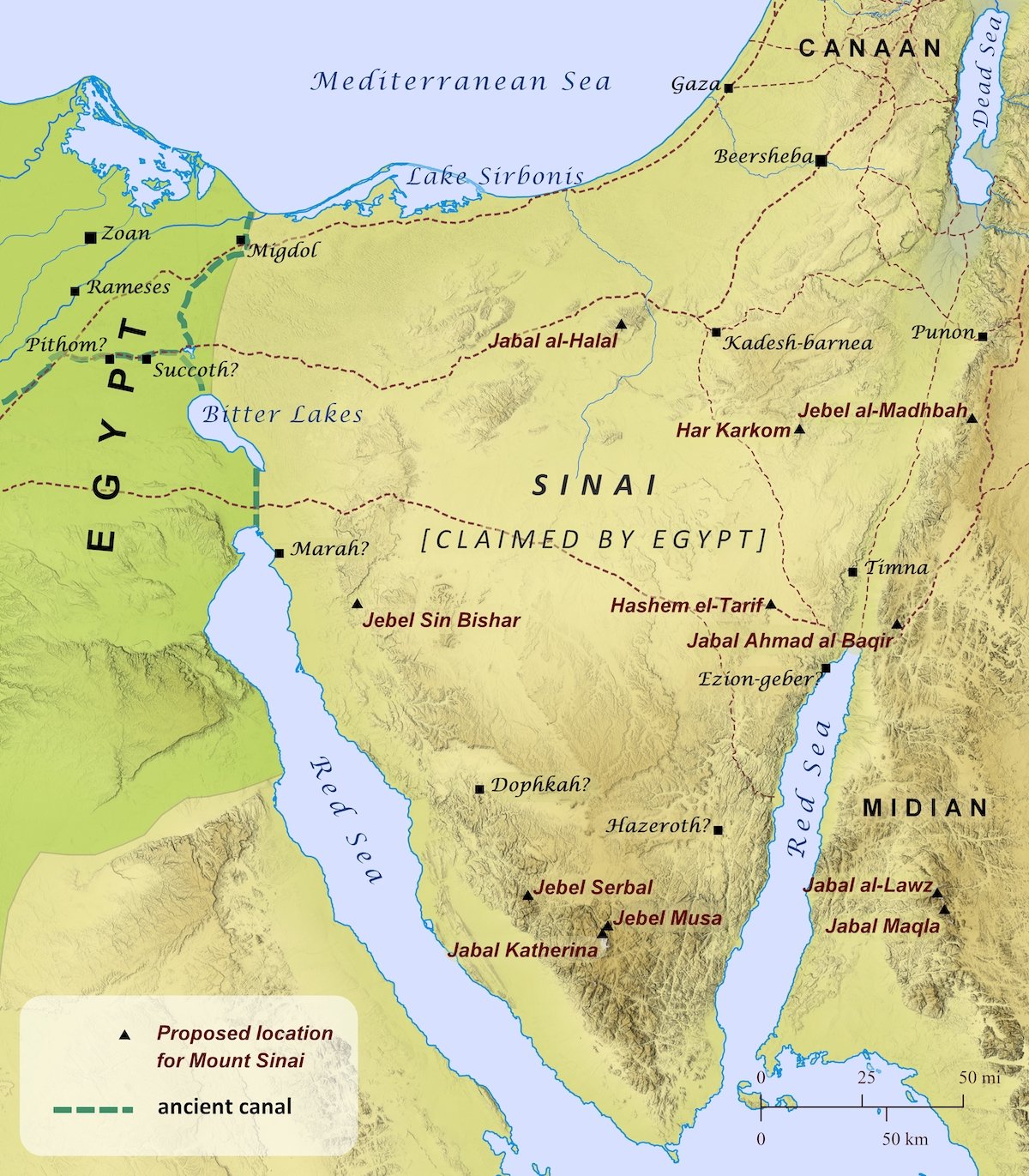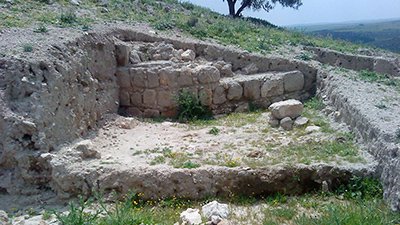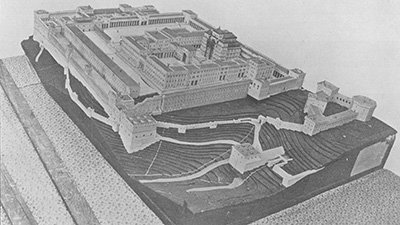
Searching for Sinai
Evaluating the options for the biblical location of Mount Sinai
The Bible tells us that after the Israelites left Egypt and crossed the Red Sea,1 yam-sûp,2 they camped 10 times before arriving at Mount Sinai (see Numbers 33:5–15).3 The Israelites arrived at Mount Sinai “on the third new moon” (ESV) or “in the third month” (NKJV) (Exodus 19:1; cf. Numbers 33:3), around two months after they departed from Egypt.4 The Israelites left Mount Sinai in the second month in the second year of the exodus (Numbers 10:11), which is a stay of just over 11 months. About half of the book of Exodus describes the events that took place at Mount Sinai (Exodus 19:1–40:38), with a few chapters focusing on the journey to Mount Sinai (Exodus 15:22–18:27). It was at Mount Sinai that God revealed himself to Israel, made a covenant with them (fulfilling the promise he made to Abraham), and gave them the Ten Commandments (or “Ten Words” thus Decalogue; Exodus 20:1–18; Deuteronomy 4:13).
Although the location of Mount Sinai is not a vital part of the Christian faith, it does hold historical and theological importance as it is the place where God revealed himself to his people, Israel.
The Bible presents Mount Sinai as a real location, and later in biblical history it took Elijah 40 days to get from Beersheba to Mount Sinai (1 Kings 19:3–8). The question is: where is Mount Sinai?5 Because of the lack of clear knowledge of some of the locations mentioned in Exodus, opinions of archaeologists and biblical scholars differ widely on its exact location.6 But can we determine its general location from data given in the Bible? According to the biblical text, the location of Mount Sinai should at least meet certain criteria: it should be an 11-day journey from Kadesh-barnea (Deuteronomy 1:2)7 and within grazing distance of the “land of Midian” (Exodus 2:15, 3:1).8 In the New Testament, the Apostle Paul compares Hagar to “Mount Sinai in Arabia” (Galatians 4:25). But where is the Arabia he was referring to (see below)? Although the location of Mount Sinai is not a vital part of the Christian faith, it does hold historical and theological importance as it is the place where God revealed himself to his people, Israel. This article will evaluate six popular sites that have been suggested as the possible location for Mount Sinai.9
Jebel Musa (South Sinai Peninsula)
The most popular location today for Mount Sinai is in the southern Sinai Peninsula.10 This is based upon Christian tradition, originating in the fourth century AD (Egeria’s Peregrinatio—AD 383/4). The mountain of Jebel Musa (Arabic for “the mountain of Moses”) rises to 7,498 feet in elevation (2,285 meters) above sea level. The Bible neither expresses how high nor how low Mount Sinai was. We do know Moses (80 years old) climbed the mountain several times (see Exodus 19:3, 19:20, 24:13, 34:4). Distinguished Egyptologist James Hoffmeier advocates the traditional southern Sinai view.11 Hoffmeier believes the yam-sûp the Israelites crossed was the Ballah Lakes in the north-eastern delta.12 This requires that the Israelites, after crossing the yam-sûp, would have then journeyed south and followed the “Mining Route” (the route used by the Egyptians for mining turquoise and copper from the Sinai mountains) along the eastern side of the Gulf of Suez. There is a plain on the north side of Jebel Musa, Er-Rahah, about a mile and a half long by half a mile wide that would have been a suitable place for the Israelites to camp.
There are, however, several problems with Jebel Musa as the location of Mount Sinai. It would seem too far from the “land of Midian” (Arabia)13 where Moses fled, for him to have been pasturing Jethro’s flock there (Exodus 2:15, 3:1).14 The one-way journey from Midian to Jebel Musa is around 225 miles (a round trip of 450 miles!). It would also seem too far from Kadesh-barnea (c. 160 miles) for the Israelites to have made the journey in 11 days (Deuteronomy 1:2).15 It is also nowhere near the road from Egypt to Midian (Exodus 4:18–27). When Moses fled from Egypt to go to Midian (Exodus 2:15), he most probably traveled along a well-established route, “the Way of the Wilderness” (Exodus 13:18), a road that goes directly from the north of the Gulf of Suez to the north tip of the Gulf of Aqaba (c. 150 miles). It would seem the main reason to believe Jebel Musa is Mount Sinai is Christian tradition from the fourth century AD, a tradition far removed from the fifteenth century BC (1446–1406 BC), the time when Moses wrote down the texts describing the revelation at Mount Sinai.

Proposed locations for Mount Sinai: Image courtesy of biblemapper.com
Jebel Sin Bishar (North Sinai Peninsula)
Jebel Sin Bishar is a mountain located in northwest Sinai and was suggested to be the biblical Mount Sinai by Menashe Har-El, a biblical geographer at Tel Aviv University.16 Har-El argues that Jebel Sin Bishar is the only mountain in the Sinai Peninsula that conserves the toponym “Sinai” in the word “Sin.”17 Har-El also claims that “the meaning of Sin Bisher is the reporting of the Law, or Laws of man. This name hints at the Giving of the Law.”18 The height of “Jebel sin Bishar is only 618 meters [2027 feet] above sea level, it is the most prominent of its surrounding.”19 Jebel Sin Bishar was favored by Har-El because it was assumed that Moses’ request to Pharoah for a three-day journey into the wilderness was to Mount Sinai (Exodus 5:3). However, Exodus 5:3 never suggests that this three-day journey was to Mount Sinai but was only to be outside of Egypt into the wilderness because the Israelites’ sacrifices were abominable to the Egyptians (Exodus 8:25–27; cf. Genesis 46:34). Jebel Sin Bishar would also be too far from the land of Midian (Arabia) for Moses to have been pasturing Jethro’s flock in that proximity (Exodus 3:1). Identifying Jebel Sin Bishar as Mount Sinai raises another question. Jebel Sin Bishar is around 30 miles from where Har-El places the crossing of the yam-sûp (Great Bitter Lake in the southern Isthmus of Suez).20 So, why did the Israelites take so long to make such a short journey? It is hard to believe that the Israelites, who came out of Egypt in haste and were able to travel by day and night (Exodus 13:21; Deuteronomy 16:3; Nehemiah 9:12, 19), took around a month to travel about 30 miles (Exodus 16:1, 19:1).
Har Karkom (North Sinai Peninsula)
Har Karkom is a mountain in the north Sinai Peninsula and is almost halfway between Gebel Khashm et-Tarif and Kadesh-barnea. The mountain and its surroundings are 1968–2788 feet above sea level. Italian archaeologist Emmanuel Anati excavated at the mountain and believed it to be Mount Sinai based upon shrines, altars, stone circles, and stone pillars. According to Anati, the height of religious activity at Har Karkom dates to the third millennium BC. Based upon a revised biblical chronology, Anati places the events of the exodus (which he believes are mythical history) around this time (c. 2200–2000 BC).21 The plateau and the valleys around Har Karkom were abandoned from 1950 BC to 1050 BC.22 Anati’s date for the exodus is hundreds of years before the biblical date for the exodus, which occurred in 1446 BC (see 1 Kings 6:1; cf. Judges 11:26).23 Therefore, Mount Har Karkom cannot be Mount Sinai.
Gebel Khashm et-Tarif (Hashem El Tarif) (North Sinai Peninsula)
Archaeologist Bryant Wood believes Gebel Khashm et-Tarif, 22 miles west-northwest of the northern end of the Gulf of Aqaba, is the most probable location for Mount Sinai.24 Following Hoffmeier, Wood places the crossing of the yam-sûp at the Ballah Lakes.25 Wood identifies several biblical requirements for the location of Mount Sinai:
- It is located at the eastern end of the Trans-Sinai Highway (Exodus 4:20, 27).
- It is located near Midian. Moses pastured the flock of Jethro at Sinai (Exodus 3:1), and Jethro and Hobab, Moses’ brother-in-law, both visited Moses while he was at Mount Sinai with the Israelites (Exodus 18:5; Numbers 10:29–30).
- It is in the right location, approximately two months’ journey from Rameses (Exodus 19:1; Numbers 33:3) and 11 days’ journey from Kadesh-barnea (Deuteronomy 1:2).
- It is in the territory of Edom (Deuteronomy 33:2; Judges 5:4; Habakkuk 3:3).
Gebel Khashm et-Tarif is at the intersection of the Trans-Sinai Highway and the Mount Seir road. If this is Mount Sinai, then the Israelites would have traveled east across the Sinai Peninsula on the Trans-Sinai Highway which runs directly across central Sinai and connects the northern end of the Gulf of Suez to the northern end of the Gulf of Aqaba (see Exodus 13:18). The travel distance from Rameses (Exodus 12:37) to Gebel Khashm et-Tarif is around 290 miles.26 From Gebel Khashm et-Tarif to Kadesh-barnea (by the Mount Seir road) is around 75 miles. Wood believes with the Israelites traveling just over seven miles a day, it is possible to achieve this journey in 11 days (Deuteronomy 1:2). Gebel Khashm et-Tarif is a relatively low mountain (2,870 feet), and Wood believes this is in accordance with certain Jewish traditions (Babylonian Talmud and Bamidbar Rabbah).27 Archaeological exploration carried out at Gebel Khashm et-Tarif has revealed 33 rectangular structures east and south of the mountain that indicates it was a holy mountain in antiquity (cf. Exodus 19:10, 12).28
Jabal al-Lawz (Arabian Peninsula)
In recent years there has been a lot of attention given to Jabal al-Lawz as the location of Mount Sinai, although Mount Sinai in Arabia is not a modern view.29 Those who hold this view place the crossing of the yam-sûp somewhere on the Gulf of Aqaba, east of the Sinai Peninsula.30 Jabal al-Lawz is in northwest Saudi Arabia and is 8,464 feet (2,580 meters) above sea level. The most well-known advocates of this position are environmental geographer Dr. Glen Fritz31 and Christian author Joel Richardson.32 Fritz argues that it took the Israelites an estimated 18–20 days to reach the yam-sûp (mid Aqaba/Nuweiba beach),33 and once they had crossed, it was another 10 days to reach the wilderness of Sin (Exodus 16:1). The exodus route (from Rameses to the yam-sûp) that Fritz follows is the low areas of the Sinai Peninsula (not the route between the heads of the Gulfs of Suez and Aqaba), which is around 277 miles.
Both Fritz and Richardson point to ancient Jewish (LXX, Philo, Josephus) and early Christian witnesses (Eusebius and Jerome) that identify the location of Mount Sinai in Arabia (Madiam = Midian).34 Both men also note that the first century Hellenistic Jewish philosopher, Philo of Alexandria, described Mount Sinai as “the loftiest and most sacred mountain in that district . . . a mountain which was very difficult of access and very hard to ascend” (Moses 2.14.70). Likewise, the first century Jewish historian Josephus stated, “Mount Sinai . . . is the highest of all the mountains that are in that country” (Antiquities 3:1). Richardson makes the point that this fits the description of Jabal al-Lawz, but again the Bible does not specify how high or low Mount Sinai was. Richardson also highlights several archaeological sites around Jabal al-Lawz that he believes serve as confirmation that it is Mount Sinai: Moses’ altar (Exodus 20:24–26), 12 pillars (Exodus 24:4), the golden calf altar (Exodus 32:1–8), the graveyard (Exodus 32:25–28), and the split rock (Exodus 17:5–6).35 Although these finds are interesting and should not be dismissed out of hand, they have not been verified by trained archaeologists.
Some argue that Mount Sinai could not have been in Midian because when Jethro left Moses at Mount Sinai, “he went away to his own country” (Exodus 18:27; cf. Numbers 10:30). However, those who hold the view that Mount Sinai is in Midian argue that the Hebrew word for “country” (erets) has a wide range of meaning (i.e., earth, country, land, region, territory) and therefore Mount Sinai could still be in Midianite territory.36 Another reason some reject Jabal al-Lawz as Mount Sinai is that it seems too far for the Israelites to travel in 11 days to Kadesh-barnea (Deuteronomy 1:2).37 The straight-line distance from Jabal al-Lawz to Kadesh-barnea is approximately 150 miles.38
Hala-‘l Badr (Arabian Peninsula)
The argument for locating Mount Sinai in northwest Arabia comes from Colin Humphreys, a physicist from Cambridge University.39 Humphreys notes that when Moses fled from Egypt, he went to the land of Midian (Exodus 2:15) where he worked as a shepherd for his father-in-law (Exodus 3:1). Humphreys locates the land of Midian in north-western Arabia, in the low coastal area called the Tihama (a region that is extremely hot in the summer). East of Tihama is a desert band called the Shifa, and behind that is the Hisma. Shepherds keep their sheep in Tihama during the winter and then cross the desert and take them to Hisma during the summer. Humphreys argues that Moses guided his sheep from the Tihama, across the desert, and into the Hisma, and there encountered the burning bush.40 This would put Mount Sinai in north-western Arabia (27.25° N, 37°12 E). Another reason for this location, according to Humphreys, is the description of Mount Sinai. When God descended onto Mount Sinai in fire to give the Ten Commandments, there was thunder and lightning, and the mountain quaked greatly and was covered in smoke like a furnace (see Exodus 19:16, 18). Humphreys believes this description is associated with a volcanic eruption.41 Others believe the description is simply a theophany (an appearance of God).42 Humphreys identifies Mount Badr in the Hisma as Mount Sinai. The volcano is on a high plateau which is around 5,000 feet above sea level, and the cone of Mount Badr is around 500 feet above that. Humphreys believes when the Israelites left Egypt, they traveled across the Sinai Peninsula along the Way of the Wilderness to the northern end of the Gulf of Aqaba where they crossed at the head. The Israelites then went down the western side of the Arabian Peninsula (east of the Gulf of Aqaba) then moved inland toward Mount Sinai.
Several English translations (ESV, NASB) indicate that Moses took his father-in-law’s flock to the west side of the wilderness. Some believe this suggests that Mount Sinai is therefore west of Midian (Exodus 3:1). However, translating the Hebrew word ʾaḥar (אַחַר) as “west” is probably not correct, as it can mean “beyond” or “to the backside of” (see KJV, NIV, TNIV).43 This would refer to the area beyond the wilderness through which Moses was leading his flocks and places Mount Sinai somewhere within or near to the land of Midian. Some also argue that Mount Badr is too far from Kadesh-barnea to be Mount Sinai. Old Testament scholar Duane Garrett, who follows Humphreys’ identification of Mount Badr as Mount Sinai, responds that this assumes Deuteronomy 1:2 is stating it took Israel 11 days to travel from Mount Sinai to Kadesh-barnea. Garrett believes Deuteronomy 1:2 does not say it took Israel 11 days to make the journey but simply describes it as an 11-day journey to highlight Israel’s failure—that it took them 40 years to get to Kadesh-barnea (Deuteronomy 1:3). Because it took Elijah 40 days to get from Beersheba to Mount Sinai (1 King 19:3–8), Garret believes this suggests “the eleven-day journey mentioned in Deut. 1:2 may be the minimum amount of time a determined traveller might take in making the journey.”44 This interpretation may be reasonable but may not persuade everyone.

This map includes the location of Hala-‘l Bedr: Image courtesy of biblemapper.com
Mount Sinai in Arabia
The Bible presents Mount Sinai as a real historical location, but more study needs to be done to be able to verify which site is the precise location.
What about the Apostle Paul’s statement, “Now Hagar is Mount Sinai in Arabia” (Galatians 4:25)? Does this mean that Mount Sinai is in the region we know today as Saudi Arabia? It is important to remember that the first century understanding of Arabia is different from that of our modern understanding (Saudi Arabia). James Hoffmeier, for example, states, “The term Arabia as used in Greco-Roman times included Sinai.”45 While this may be true, the term Arabia also included the Arabian Peninsula. In Roman times, the word Arabia was used in a very broad sense and could refer to Arabia Petra46 (south and east of the Dead Sea, i.e., Edom), Arabia Deserta (north Arabian Peninsula), and Arabia Felix (southwestern coast of Arabia but could refer to the whole Arabian Peninsula). After examining these three geographic descriptions of Arabia, Garrett concludes, “It is not impossible, one may say, that Paul’s ‘Arabia’ included the Sinai Peninsula, but it is more likely that, writing during the Roman period to a Gentile audience in Galatia, Paul used the standard Roman era meanings for ‘Arabia’ (referring to Arabia Petra or Arabia Felix). This places it either south of the Dead Sea or in the Arabian Peninsula.”47 The Arabian Peninsula view would fit with where Hagar and her son Ishmael’s descendants settled, east of Canaan, in northwest Arabia (Genesis 25:6, 18).
No doubt the debate over the location of Mount Sinai will continue. But in the end, several sites are clearly problematic for being identified as Mount Sinai while other sites have strengths and weaknesses. The Bible presents Mount Sinai as a real historical location, but more study needs to be done to be able to verify which site is the precise location.
Footnotes
- The English translation “Red Sea” is based on the Greek translation (Erythra Thalassē; cf. Acts 7:36; Hebrews 11:29). Scholars debate whether the Hebrew yam-sûp means “Sea of reeds” or “Sea of the end.”
- The question of where the Israelites crossed the yam-sûp is disputed with several suggestions given: 1) Lake Menzaleh, 2) Bitter Lakes, 3) Lake Timsah, 4) Ballah Lakes, 5) Gulf of Suez, 6) Gulf of Aqaba (there are several possible crossing points associated with this possibility: a) lakes north of Aqaba, b) Northern Aqaba, c) Mid Aqaba/Nuweiba beach, d) Southern Aqaba [Strait of Tiran]). The location of Mount Sinai is linked to the place where Israel crossed the yam-sûp. Most scholars who believe the crossing was close to Egypt locate Mount Sinai somewhere near Egypt. However, those who believe Israel crossed the yam-sûp at the Gulf of Aqaba place Mount Sinai somewhere in the Arabian Peninsula.
- The places the Israelites camped when they left Egypt are 1) Succoth, 2) Etham, 3) Pi-hahiroth, Migdol, Baal-zephon, and the yam-sûp (four names identifying a single camp site), 4) Marah, 5) Elim, 6) yam-sûp, 7) wilderness of Sin, 8) Dophkah, 9) Alush, 10) Rephidim, 11) Mount Sinai. We do not know the exact amount of time that Israel traveled between each camp site, however, it took Israel about a month to get to the wilderness of Sin (Exodus 16:1).
- Old Testament scholar Duane Garrett states, “There is some confusion about when Israel arrived at Sinai. The most reasonable interpretation is that they arrived on the fifteenth day of the third calendar month, that is, two months to the day after their departure from Egypt. The essential chronology is that they left Egypt on the morning after the Passover meal (the 14th day of the 1st month; 12:41), arrived at the Wilderness of Sin on the 15th day of the 2nd month (16:1), and arrived at Mt. Sinai on the 15th day of the 3rd month.” Duane A. Garrett, A Commentary on Exodus (Grand Rapids, MI: Kregel Academic, 2014), 458. Carpenter agrees that it took Israel around two months to get to Mount Sinai. Eugene Carpenter, Exodus 19–40: Evangelical Exegetical Commentary (Bellingham, WA: Lexham Press, 2016), 6.
- The book of Exodus refers to Mount Sinai 13 times (Exodus 16:1, 19:1, 19:2, 19:11, 19:18, 19:20, 19:23, 24:16, 31:18, 34:2, 34:4, 34:29, 34:32) and by the alternative name Horeb 3 times (Exodus 3:1, 17:6, 33:6).
- For example, the exact location of Etham (Exodus 13:20), Pi-hahiroth, Migdol, Baal-zephon (Exodus 14:2), and Shur (Exodus 15:22) are disputed.
- Kadesh-barnea is located at the southern edge of Canaan (at the northern edge of the Sinai Peninsula).
- Alexander comments on Exodus 2:15: “The addition of the noun ‘land’ clarifies that Midian refers in this context to a specific region, the area around the Gulf of Aqaba.” T. Desmond Alexander, Exodus (London: Apollos, 2017), 65.
- Other sites have been thought to be Mount Sinai. For example, a site on the map below, Jabal Ahmad al Baqir, northeast of the Gulf of Aqaba, was proposed to be Mount Sinai by the British geographer Charles Beke in his book Sinai in Arabia and of Midian (1878).
- Many maps in the back of Bibles locate Mount Sinai here.
- James K. Hoffmeier, Ancient Israel in Sinai: The Evidence for the Authority of the Wilderness Tradition (Oxford University Press, 2005), 148.
- Hoffmeier, Ancient Israel in Sinai, 88. The Israelites assessment of their location before they crossed the yam-sûp (in the wilderness and outside of Egypt, Exodus 14:11) does not agree with Hoffmeier’s placement of them on the west side of the Ballah Lakes, which is in Egypt. Israel was not told to travel “by way of the land of the Philistines” (i.e., the Way of Horus, the southeast coastline of the Mediterranean Sea) but to go “by the way of the wilderness toward the Red Sea.” (Exodus 13:17–18). This was in the wilderness (Sinai Peninsula) and outside of the land of Egypt.
- Although the Midianites were nomadic (see Genesis 36:35, 37:28) they did have a specific homeland: “The region east of the Gulf of Aqaba in northwest Arabia has the strongest claim to being the central location of the Midianite people.” John H. Walton, Victor H. Matthews, and Mark W. Chavalas, The IVP Bible Background Commentary: Old Testament (Downers Grove, IL: IVP Academic, 2000), 79.
- This is unless you assume that Moses lived with a branch of the Midianites, to whom Jethro was a priest, who had crossed the Gulf of Aqaba and settled in the southern half of the Sinai Peninsula. But this is highly unlikely as Exodus 2:15 states that Moses settled in “the land of Midian” and not among a group of Midianite people.
- This assumes that the Israelites could travel no more than 7–10 miles per day. It has been argued that the Israelites could possibly travel around 20 miles a day. See the documentary film Patterns of Evidence: The Red Sea Miracle 1&2.
- Menashe Har-El, The Sinai Journeys, The Route of the Exodus (San Diego: Ridgefield Publishing, 1983), 420–421.
- Har-El, The Sinai Journeys, 421.
- Har-El, The Sinai Journeys, 421.
- Har-El, The Sinai Journeys, 421.
- Har-El, The Sinai Journeys, 351.
- Emmanuel Anati, Is Har Karkom the Biblical Mount Sinai? (Italy: Atelier, 2013), 80–81.
- Anati, Is Har Karkom, 19.
- According to biblical chronology, the Israelite exodus from Egypt took place in 1446 BC (1 Kings 6:1 tells us that the Exodus from Egypt took place in the 480th year before the construction of the temple, which was in 967 BC. 967 + 479 = 1446 BC).
- Bryant G. Wood, “In Search of Mt. Sinai,” Associates for Biblical Research, April 4, 2008, https://biblearchaeology.org/research/chronological-categories/exodus-era/4133-in-search-of-mt-sinai.
- See Associates for Biblical Research, “Mount Sinai and the Red Sea Crossing (Part One): Digging for Truth Episode 72,” YouTube, December 1, 2019, https://www.youtube.com/watch?v=xiwQ0KtD3fI.
- Bryant G. Wood, “What Do Mt. Horeb, The Mountain of God, Mt. Paran and Mt. Seir Have to Do with Mt. Sinai?” Associates for Biblical Research, November 17, 2008, https://biblearchaeology.org/research/chronological-categories/exodus-era/4012-what-do-mt-horeb-the-mountain-of-god-mt-paran-and-mt-seir-have-to-do-with-mt-sinai.
- This is contrary to the belief of Jewish teachers Philo and Josephus who argued that Mount Sinai was the highest mountain in the region (see below).
- See Associates for Biblical Research, “Mount Sinai and the Red Sea Crossing (Part Two): Digging for Truth Episode 73,” YouTube, December 8, 2019, https://www.youtube.com/watch?v=BM5sbvr9U5M.
- The belief that Mount Sinai is in Arabia goes back to archaeologists and historians in the 1800s (see footnote 9). Egyptologist and Assyriologist A. H. Sayce states, “For I also am one of the heretics who regard the pilgrim to the Sinaitic Peninsula as wasting his enthusiasm over imaginary sites. The Old Testament and the Egyptian monuments alike seem to me to forbid our placing Mount Sinai in the so-called Sinaitic Peninsula or believing that the Israelites could ever have wandered for forty years in that pastureless and uninviting region . . . It may seem cruel to disturb the convictions of the numerous travellers who have patiently supported the fatigues of a journey among the monotonous and inhospitable rocks of the so-called Sinaitic Peninsula under the belief that they were treading in the steps of the children of Israel, and I fear that the Cairo dragoman who finds that the belief puts money in his pocket will not thank me for my scepticism. But in spite of the tradition of the last sixteen centuries, that belief is, as I have endeavoured to show, contrary to the combined evidence of the Old Testament and the Egyptian monuments. Where the mountain-peak of Sinai actually was we do not know; perhaps we never shall; but of one thing we may be certain, and that is that it was not in the Peninsula which is now called Sinaitic . . . Those who would follow in their path should explore Midian and Edom, rather than the Wadis of the old Egyptian territory of Mafkat.” A. H. Sayce, “Imperial and Asiatic Quarterly Review,” 1893, vi. 149.
- Not everyone who holds that Mount Sinai is Jabal al-Lawz believes the Israelites crossed the yam-sûp at the Gulf of Aqaba. Some believe a crossing near the north of the Gulf of Suez and Mount Sinai in Arabia also fits the biblical timeline.
- See Glen Fritz, The Exodus Mysteries of Midian, Sinai & Jabal al-Lawz (GeoTech, 2019).
- See Joel Richardson, Mount Sinai in Arabia (Wine Press Media, 2019).
- The sea at the Nuweiba beach (Gulf of Aqaba) is 9.6 miles wide and has a maximum depth of 850 meters, and so it raises the question: is this too deep and steep for children, the elderly, and livestock to cross?
- Glen Fritz, “Proof of Mount Sinai in Arabia,” Ancient Exodus, https://ancientexodus.com/proof-of-mount-sinai-in-arabia/; Richardson, Mount Sinai in Arabia, 67–68, 72–73.
- Richardson, Mount Sinai in Arabia, 105–120.
- Based on the semantic range of erets, Richardson argues, “In looking at the wide range of meanings for erets, we see there is nothing in the text indicating that Sinai was not in the land of Midian. Nothing in the text requires Jethro to have been in one geopolitically defined ‘country’ and about to depart to another. They were in Midianite territory at Mount Sinai and then Jethro went back to his home, which was fifteen to thirty miles away.” Richardson, Mount Sinai in Arabia, 129.
- See “Thoughts on Jebel Al Lawz as the location of Mount Sinai?” Associates for Biblical Research, https://biblearchaeology.org/research/exodus-from-egypt/4217-thoughts-on-jebel-allawz-as-the-location-of-mount-sinai?highlight=WyJqZWJlbCIsIm11c2EiLCJqZWJlbCBtdXNhIl0=.
- The Israelites would need to travel around 14 miles a day to reach Kadesh-barnea in 11 days.
- See Colin J. Humphreys, The Miracles of Exodus: A Scientist’s Discovery of the Extraordinary Natural Causes of the Biblical Stories (New York: Harper Collins, 2004).
- Humphreys, The Miracles of Exodus, 61–69.
- Humphreys, The Miracles of Exodus, 82–93.
- Hoffmeier, Ancient Israel in Sinai, 157; Glen Fritz, “Was Mount Sinai a Volcano?” Ancient Exodus, 2016 https://ancientexodus.com/was-mount-sinai-a-volcano/.
- Garrett states, “Setting aside Exod. 3:1, there are 235 occurrences of אַחַר or אַחֲרֵי in the Pentateuch; it does not mean ‘west’ in a single instance. In short, it is incorrect to translate אַחַר הַמִּדְבָּר in Exod. 3:1 as ‘west of the wilderness.’ It means, ‘the back side of the wilderness,’ as reflected in the KJV, NIV, TNIV and NRSV.” Garrett, A Commentary on Exodus, 189.
- Garrett, A Commentary on Exodus, 129.
- Hoffmeier, Ancient Israel in Sinai, 130.
- Arabia Petra (or Arabia-Petraea) was not known by this name until the Roman conquest in AD 106—after Paul’s time.
- Garrett, A Commentary on Exodus, 132–133.
Recommended Resources

Answers in Genesis is an apologetics ministry, dedicated to helping Christians defend their faith and proclaim the good news of Jesus Christ.
- Customer Service 800.778.3390
- © 2024 Answers in Genesis







